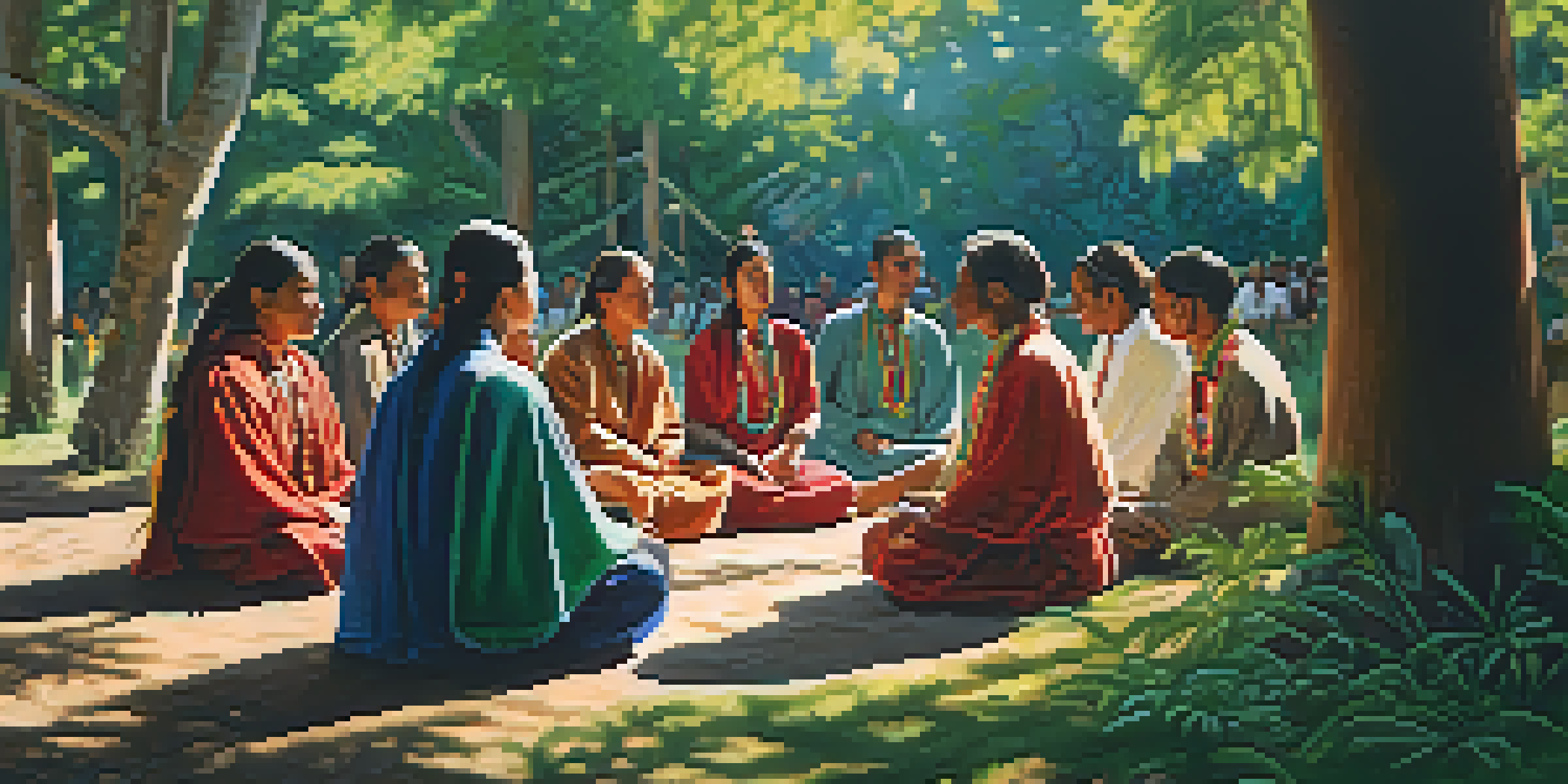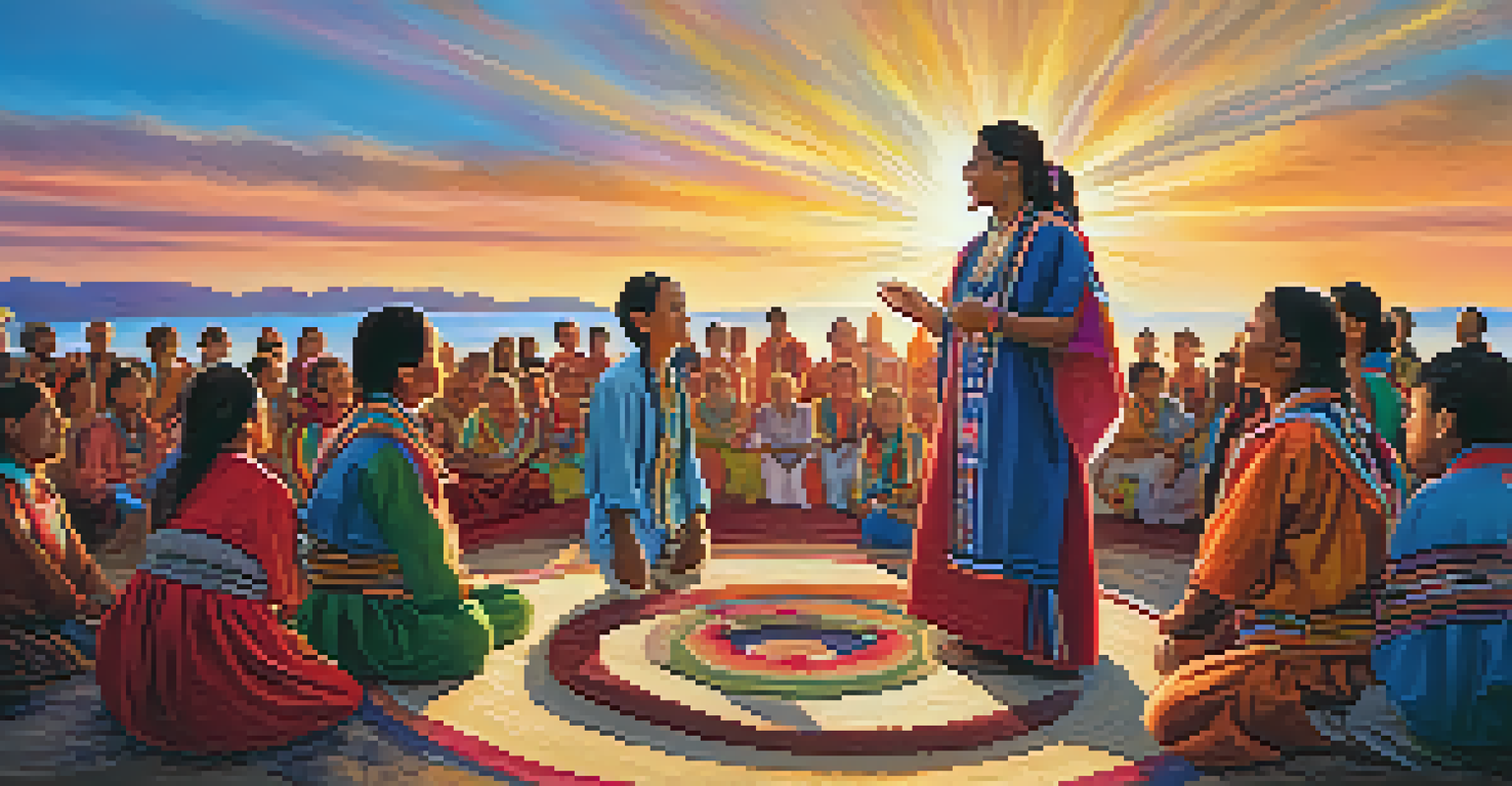Peyote Ceremonies: The Power of Group Singing and Unity

Understanding Peyote Ceremonies and Their Significance
Peyote ceremonies are deeply rooted in Indigenous cultures, particularly among Native American tribes. These rituals, which often involve the consumption of peyote cactus, are aimed at spiritual healing and communion with the divine. Participants seek guidance, clarity, and a deeper understanding of their life path through these sacred experiences.
The circle represents the sacredness of life, the unity of all things, and the importance of community.
The ceremonies typically occur in a circle, fostering a sense of community and shared purpose among participants. This physical arrangement symbolizes equality and interconnectedness, reinforcing the idea that everyone’s journey is respected and valued. The atmosphere is often filled with a sense of reverence, with participants expressing gratitude for the sacred medicine they are about to receive.
As the ceremony unfolds, the combination of peyote’s psychoactive effects and the communal environment can lead to profound experiences. Participants frequently report insights and emotional releases that contribute to personal and collective healing. This powerful synergy between the plant medicine and the group dynamic is a hallmark of Peyote ceremonies.
The Role of Music in Peyote Ceremonies
Music plays a vital role in Peyote ceremonies, with group singing being one of the primary forms of expression. Traditional songs are often passed down through generations, carrying deep spiritual significance and cultural heritage. These songs help to create a sacred space, inviting participants to connect with each other and the spiritual realm.

Singing together can evoke a sense of unity, reminding participants that they are part of something greater than themselves. This shared experience can foster emotional bonds and enhance feelings of belonging within the group. It’s not just about the melody; it's about the collective energy created when voices come together in harmony.
Peyote Ceremonies Foster Unity
These rituals create a sense of community and interconnectedness among participants, enhancing personal and collective healing.
Furthermore, the act of singing can serve as a form of prayer, directing intentions and gratitude towards the divine. It allows participants to express their emotions and experiences in a safe and supportive environment. In this way, music becomes a conduit for healing, transformation, and spiritual exploration.
The Power of Group Singing in Creating Unity
Group singing in Peyote ceremonies transcends mere entertainment; it’s a powerful tool for fostering unity among participants. When individuals come together to sing, they often experience a sense of oneness, which can amplify the effects of the peyote experience. This collective resonance can lead to synchronized emotional and spiritual states, enhancing the overall impact of the ceremony.
Music is the universal language of mankind, and it can create connections that transcend barriers.
The shared act of singing also promotes vulnerability, as participants open their hearts and voices in unison. This vulnerability can lead to deeper connections and empathy among participants, creating a nurturing environment where everyone feels seen and heard. The bonds formed during such moments can last well beyond the ceremony itself.
Moreover, the communal singing serves as a reminder of the importance of collaboration and support in one’s personal journey. It emphasizes that healing is not an isolated endeavor but a shared experience that can be enriched through community. This sense of camaraderie can be incredibly uplifting, reinforcing the notion that we are stronger together.
Peyote and Its Effects on Group Dynamics
Peyote, known for its psychoactive properties, can significantly impact group dynamics during ceremonies. As participants ingest the cactus, they may experience altered perceptions and heightened emotional states. This can lead to profound moments of introspection and connection, both individually and collectively.
The effects of peyote can encourage honest communication and sharing among participants, breaking down barriers that might exist in everyday life. Participants often find themselves more open to discussing their feelings, fears, and dreams, which can deepen relationships within the group. This openness is crucial in creating a supportive environment for healing.
Music Enhances Spiritual Connection
Group singing during Peyote ceremonies acts as a powerful tool for emotional bonding and serves as a form of prayer.
Additionally, the shared experience of navigating the effects of peyote together can foster a sense of solidarity. Participants may find comfort in knowing they are not alone in their journeys, as they collectively face challenges and insights. This camaraderie can reinforce the bonds formed during the ceremony, creating lasting relationships grounded in mutual understanding.
The Symbolism of the Circle in Peyote Ceremonies
The circle is a powerful symbol in Peyote ceremonies, representing unity, equality, and the cyclical nature of life. By gathering in a circle, participants physically manifest their interconnectedness and shared purpose. This arrangement fosters an environment where everyone’s voice matters, promoting inclusivity and respect.
In many Indigenous cultures, circles are seen as sacred shapes that reflect balance and harmony. They symbolize the idea that all beings are part of a larger whole, reinforcing the understanding that individual journeys contribute to the collective experience. This perspective encourages participants to view their personal healing as intertwined with the healing of the community.
Moreover, the circular formation allows for a 360-degree connection, enabling participants to engage with one another more effectively. This layout encourages eye contact, shared energy, and a sense of presence that enhances the overall experience. By creating a physical and symbolic space for unity, the circle becomes a vital aspect of the ceremony.
Integrating Modern Practices into Traditional Ceremonies
As society evolves, many Peyote ceremonies have begun to integrate modern practices while honoring traditional roots. This blending can include contemporary music styles or new forms of artistic expression, creating a dynamic atmosphere that appeals to younger generations. While these adaptations may vary, the core values of unity and healing remain intact.
Incorporating modern elements can help make Peyote ceremonies more accessible to those unfamiliar with traditional practices. By introducing familiar musical styles or artistic expressions, facilitators can create a bridge that invites newcomers to participate. This inclusivity can lead to broader understanding and appreciation of Indigenous cultures.
Circle Symbolizes Equality
The circular formation in ceremonies embodies unity and respect, reinforcing the idea that everyone’s journey is valued.
However, it’s crucial to approach this integration with respect and mindfulness, ensuring that the essence of the ceremony is preserved. Facilitators must be aware of the cultural significance of the rituals and seek guidance from Elders or knowledgeable community members. This balance between tradition and innovation can enrich the experience for all participants.
The Lasting Impact of Peyote Ceremonies on Participants
Participants often leave Peyote ceremonies with a renewed sense of purpose and connection to themselves and their community. The insights gained during these rituals can lead to transformative changes in their lives, fostering personal growth and healing. Many individuals report feeling more aligned with their true selves and more connected to the world around them.
The bonds formed during the ceremony typically extend beyond the event itself, creating a network of support among participants. This shared experience can lead to ongoing relationships, where individuals continue to uplift each other in their journeys. The sense of belonging cultivated during the ceremony can be a powerful source of strength in everyday life.

Ultimately, Peyote ceremonies serve as a reminder of the profound impact that communal experiences can have on individual well-being. They highlight the importance of connection, unity, and shared healing, encouraging participants to carry these values into their daily lives. The lessons learned and the relationships built during these ceremonies can resonate long after the peyote effects have faded.